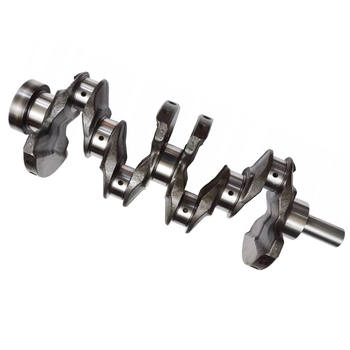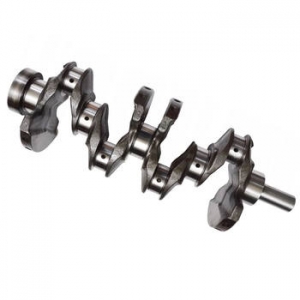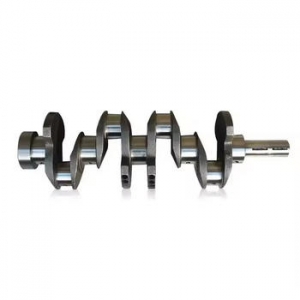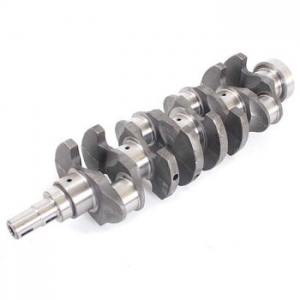The Unseen Powerhouse: Unveiling the World of an OEM Crankshaft Manufacturer
Views :
Update time : 2025-06-21
In the intricate dance of an internal combustion engine, few components are as critical, yet often unseen, as the crankshaft. It's the very backbone, converting the linear motion of pistons into rotational energy that powers everything from your daily commute to heavy industrial machinery. But who creates these marvels of engineering with the precision and reliability demanded by global industries? Enter the OEM crankshaft manufacturer. These specialized entities are not just suppliers; they are strategic partners, engineering the heart of countless engines with unwavering dedication to quality and performance.
To be honest, the role of an OEM crankshaft manufacturer goes far beyond mere production. It involves deep collaboration with engine designers, rigorous material science, cutting-edge manufacturing techniques, and an obsessive commitment to quality control. Without their expertise, the engines we rely on daily simply wouldn't function as efficiently or reliably. Have you ever wondered about the immense engineering that goes into these vital components? Let's delve into their world.
What Defines an OEM Crankshaft Manufacturer?
An Original Equipment Manufacturer (OEM) crankshaft manufacturer stands distinct from aftermarket suppliers. The core difference lies in their direct partnership with the original equipment producers – the companies that design and build engines, vehicles, or industrial machinery. This relationship is built on trust, shared specifications, and a commitment to delivering components that meet the exact, often proprietary, designs and performance standards of the end product.Beyond the Basics: Precision and Partnership
For an OEM crankshaft manufacturer, every component is crafted to precise, often minuscule, tolerances. These aren't generic parts; they are custom-engineered solutions designed to integrate seamlessly into a specific engine model. This requires a level of precision crankshaft manufacturing that few can achieve. It's about understanding the engine's entire ecosystem – its power output, vibration characteristics, thermal loads, and expected lifespan – and designing a crankshaft that optimizes all these factors.The OEM Standard: Why It Matters
The "OEM standard" isn't just a label; it's a benchmark for quality, durability, and fit. When you choose an OEM part, you're getting a component identical to the one originally installed in the engine. This means: * Exact Fit and Function: No modifications needed, ensuring optimal performance and longevity. * Guaranteed Quality: Manufactured under strict quality control protocols, often exceeding industry standards. * Material Integrity: Use of specific, high-grade materials chosen for their strength, fatigue resistance, and wear properties. * Warranty Protection: Often backed by the engine or vehicle manufacturer's warranty. Interestingly enough, this close collaboration often begins at the engine design phase, allowing the OEM crankshaft manufacturer to contribute their specialized knowledge to optimize the crankshaft's design for manufacturability, performance, and cost-effectiveness. It's a symbiotic relationship that ensures the engine's heart beats perfectly from day one.The Intricate Process of Crankshaft Manufacturing
The journey of a crankshaft from raw material to a finished, high-precision component is a testament to modern engineering and manufacturing prowess. It's a multi-stage process that combines heavy industry with microscopic precision.From Raw Material to Finished Product
The process typically begins with high-grade steel, often alloyed with elements like chromium, molybdenum, or nickel to enhance strength, toughness, and wear resistance. This raw material is then transformed through one of two primary methods: * Forging: This involves heating the steel to extremely high temperatures and then shaping it under immense pressure using dies. Forging creates a continuous grain flow, enhancing the crankshaft's strength and fatigue resistance, making it ideal for high-performance and heavy-duty applications. * Casting: This method involves pouring molten metal into a mold. While generally less expensive and suitable for complex shapes, cast crankshafts are typically used in less demanding applications compared to forged ones.Key Stages of Production
Once the blank is forged or cast, it undergoes a series of meticulous processes: 1. Rough Machining: Excess material is removed, and the basic shape of the crankshaft begins to emerge. This stage uses powerful CNC machines to achieve initial dimensions. 2. Heat Treatment: This critical step alters the microstructure of the steel to improve its hardness, strength, and wear resistance. Processes like induction hardening or nitriding are commonly used on bearing journals and fillets. 3. Precision Machining: This is where the magic of precision crankshaft manufacturing truly shines. Using multi-axis CNC machines, the main journals, rod journals, counterweights, and flange are ground and polished to incredibly tight tolerances. The surface finish is paramount for bearing longevity and engine efficiency. 4. Balancing: Crankshafts must be perfectly balanced to prevent vibrations that can lead to premature engine wear and failure. This involves dynamic balancing machines that detect imbalances, followed by material removal (drilling holes in counterweights) or addition (attaching weights) until the crankshaft is within specified balance limits. 5. Fillet Rolling/Shot Peening: These processes strengthen the critical fillet areas (where journals meet webs) by inducing compressive stresses, significantly improving fatigue life. 6. Final Inspection: Every crankshaft undergoes a battery of tests to ensure it meets all specifications. More on this in the next section.
Quality Control and Testing: The Heartbeat of Reliability
For an OEM crankshaft manufacturer, quality control isn't an afterthought; it's an integral part of every stage of production. Given the crankshaft's role as the engine's core, any defect can lead to catastrophic failure. Therefore, the testing protocols are exceptionally rigorous, ensuring uncompromising performance and reliability.Ensuring Uncompromising Performance
In my experience, the commitment to quality begins with raw material verification. Incoming materials are thoroughly analyzed for chemical composition and mechanical properties to ensure they meet the stringent specifications. This foundational step prevents potential issues from propagating down the production line.Advanced Inspection Techniques
As the crankshaft progresses through manufacturing, it undergoes multiple checks: * Dimensional Metrology: Using CMM (Coordinate Measuring Machine) and other advanced gauging equipment, every critical dimension – journal diameters, lengths, run-out, concentricity – is verified to micron-level accuracy. * Non-Destructive Testing (NDT): Techniques like magnetic particle inspection (MPI) and ultrasonic testing (UT) are used to detect surface and sub-surface cracks or material flaws that are invisible to the naked eye. * Hardness Testing: Verifying the effectiveness of heat treatment processes on critical wear surfaces. * Surface Finish Analysis: Profilometers measure the roughness of journal surfaces, ensuring they are smooth enough for optimal bearing performance and oil film retention. * Dynamic Balancing: As mentioned, this is a final, crucial step to eliminate vibrations and ensure smooth engine operation. * Fatigue Testing: While not performed on every production unit, sample crankshafts are subjected to accelerated fatigue tests to validate design and material choices, simulating years of engine operation in a matter of weeks. Many experts agree that these comprehensive testing regimes are what truly differentiate an OEM crankshaft manufacturer. They don't just produce parts; they produce certified, reliable components engineered for the long haul. This meticulous attention to detail is why engines with OEM crankshafts are known for their longevity and consistent performance.Technological Advancements Shaping the Industry
The world of crankshaft manufacturing is far from static. Continuous innovation in materials, design, and production methodologies is pushing the boundaries of what's possible, enabling the creation of lighter, stronger, and more efficient crankshafts.Innovations in Materials and Design
The drive for fuel efficiency and reduced emissions has led to significant advancements in material science. OEM crankshaft manufacturers are exploring: * Lighter Alloys: While steel remains dominant, research into lighter, high-strength alloys (e.g., advanced cast irons, even some composite materials for specialized applications) aims to reduce rotational mass, thereby improving engine responsiveness and fuel economy. * Advanced Forging Techniques: New forging processes allow for more complex shapes and closer-to-net-shape components, reducing the amount of material that needs to be machined away, saving time and resources. * Optimized Geometries: Sophisticated CAD/CAM (Computer-Aided Design/Manufacturing) and FEA (Finite Element Analysis) software allow engineers to simulate stress points and optimize crankshaft geometry for maximum strength and minimum weight, often leading to innovative designs for custom engine components. This includes hollow journals or optimized counterweight shapes.Automation and AI in Production
The factory floor of a leading OEM crankshaft manufacturer is a showcase of advanced automation: * Robotics: Robots handle heavy lifting, material transfer, and even precision tasks like deburring and polishing, improving consistency and safety. * IoT and Data Analytics: Sensors on machines collect vast amounts of data on temperature, vibration, tool wear, and production rates. This data is analyzed using AI algorithms to predict maintenance needs, optimize machine parameters, and identify potential quality issues before they arise. This predictive maintenance minimizes downtime and maximizes throughput. * Additive Manufacturing (3D Printing): While not yet mainstream for production crankshafts, additive manufacturing is being explored for prototyping complex designs and creating specialized tooling, potentially revolutionizing how new designs are brought to market. These technological leaps not only enhance the efficiency and precision of manufacturing but also contribute to the development of next-generation engines that are more powerful, more efficient, and more environmentally friendly.Choosing the Right OEM Crankshaft Manufacturer: What to Look For
For engine builders, vehicle manufacturers, or industrial equipment producers, selecting the right OEM crankshaft manufacturer is a strategic decision that impacts product quality, supply chain reliability, and ultimately, market reputation. It's not just about finding a supplier; it's about finding a long-term partner.Experience and Reputation
A manufacturer's track record speaks volumes. Look for companies with a proven history of supplying to reputable engine and vehicle brands. Their longevity in the industry often indicates consistent quality, adaptability to new technologies, and strong customer relationships. Online reviews, industry accolades, and case studies can provide valuable insights.Capabilities and Certifications
Assess their manufacturing capabilities. Do they have the capacity to meet your production volumes? Do they specialize in the types of crankshafts you need (e.g., forged, cast, specific materials)? Crucially, check for relevant certifications such as ISO 9001 (Quality Management), IATF 16949 (Automotive Quality Management System), and ISO 14001 (Environmental Management). These certifications are not just pieces of paper; they demonstrate a commitment to world-class processes and continuous improvement. Frankly speaking, without these, you're taking a significant risk.Supply Chain and Global Reach
In today's global economy, a manufacturer's supply chain robustness and global presence are increasingly important. Can they ensure timely delivery, even in challenging logistical environments? Do they have a global footprint that can support your manufacturing locations or expansion plans? Many experts agree that a diversified and resilient supply chain is key to avoiding costly production delays. This is particularly relevant for automotive crankshaft suppliers who must navigate complex international logistics. I've found that the best OEM crankshaft manufacturers are those that offer not just manufacturing services but also engineering support, collaborating closely with their clients from initial design concepts through to mass production. They act as an extension of your own R&D and production teams, ensuring the crankshaft is perfectly optimized for your specific application. In conclusion, the role of an OEM crankshaft manufacturer is absolutely indispensable to the modern engineering landscape. They are the unsung heroes, meticulously crafting the very heart of engines that power our world. Their dedication to precision, relentless pursuit of quality, and embrace of technological innovation ensure that every crankshaft they produce is a testament to engineering excellence. As engines evolve, so too will the demands on these manufacturers, pushing them to continue innovating and delivering the reliable performance we all depend on.For more detailed information, please visit our official website:OEM crankshaft manufacturer
About the author: Dr. Alistair Finch is a veteran mechanical engineer with over 25 years of experience specializing in powertrain design and manufacturing. His extensive career has seen him consult for leading automotive and industrial engine manufacturers worldwide, focusing on optimizing component performance and production efficiency. Dr. Finch is a passionate advocate for precision engineering and advanced manufacturing techniques, with a particular expertise in the intricacies of crankshaft design and fabrication.
Related News
Read More >>
 The Unseen Powerhouse: Unveili
The Unseen Powerhouse: Unveili
06 .21.2025
Discover the vital role of an OEM crankshaft manufacturer in engine performance and reliability. Lea...
 Revitalizing Power: A Deep Div
Revitalizing Power: A Deep Div
06 .21.2025
Discover the critical role of crankshaft repair services in restoring engine performance and extendi...
 The Ultimate Guide to Finding
The Ultimate Guide to Finding
06 .21.2025
Looking for a crankshaft? Discover essential tips, types, and where to find the perfect crankshaft f...
 Unlocking Engine Power: Your D
Unlocking Engine Power: Your D
06 .21.2025
Discover how to select the best wholesale crankshaft supplier for your needs. Learn about quality, t...
